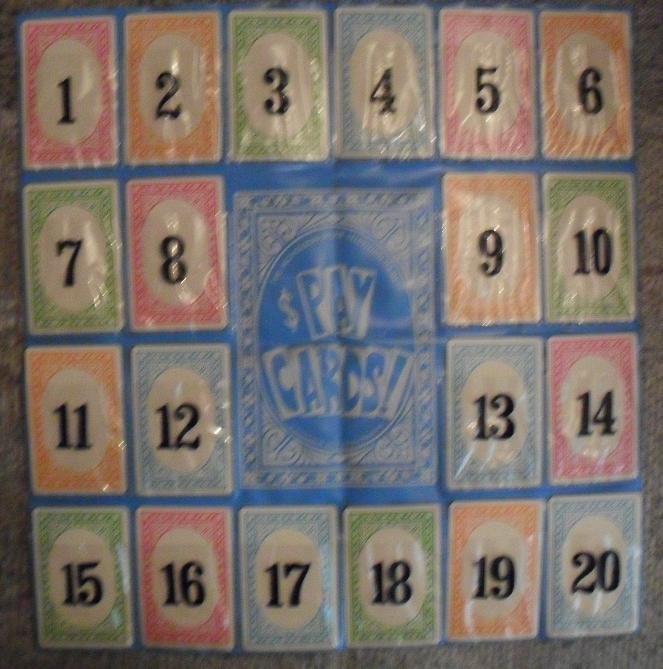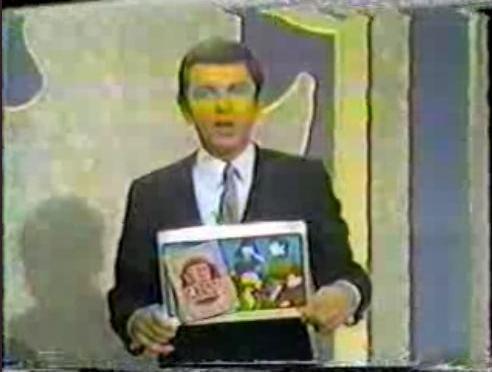PAY CARDS!
(Whitman 1969)

Not how the game is meant to be played, but may be more unpredictable.
NOTE TO COLLECTORS:
There are three distinct versions of the Pay Cards! home game: Version I (covered here), Version II (only slightly different), and Version III (can be seen over here). I know of two people who have Version I (myself and Bob Zager), and two who have Version II or III (Adam Nedeff and Keith Malkowski). The following is a review of Version I, although afterward I'll detail the differences between the three versions.
COMMENTS:
I bought my copy from eBay for about $20 and, despite having some pretty old rubber bands in there (since disposed of), has held up very nicely for a 40-year-old game. The cover illustration and cards are very nicely drawn (although about 15 or so cards appear to have gotten some dirt on them), and the game board is almost exactly as it was on the show (minus the chroma-key, which would've jacked up the price far too high for an adaptation of such a low-profile series). My brother found it much better that the board was numbered instead of the cards, but numbering the cards doesn't even make sense...
The spinner's "legs" have become weak over the years, but manages to stand up on its own just fine. The play money is decent, but not particularly decorative - and one of the denominations looks markedly different from the others.
The rules for using three players, as you'll see below, are a bit strange (and the rules themselves seem to switch between using two and three players, which annoyed me when I was typing out a summary of them) but otherwise faithful to the show's basics and easy to change if you want to play the Super revival, which was a definite plus for me.
I kind of wish the outside didn't say "For 3 or More Players" when the inside-lid instructions say "For 2 or More Players", though - and while I found it funny that the board game was "Based on the New Television Series" when said series was on its way out, turns out it aired daily in first-run with no repeats. I also wish that the back of the box had some promotion for the game like they do today, because as it was released I doubt it was an easy sell.
Overall, there are no questions that got outdated ten years later, no tiny parts that'll rattle around in the box and/or get lost, and no overly-complicated rules. As the box proclaims, this is a game that can be played by the whole family without either adults or children feeling like the game is beneath/above their age bracket.
Copies appear to be scarce, but a quick search of eBay will probably turn up one or two copies. If you can find it, get it; if you can find the Super board game (1981), get it and share some pics with the rest of us. Highly-recommended in my book.
(I should also note that Pay Cards! is a game that can be played without the board, using several decks of normal playing cards. That said, I doubt most people will have the patience, time, and/or resources to do such a thing.)
CONTENTS:
Three decks of playing cards for use in regular play (20 each of Red, Green, and Orange)
A deck of 12 playing cards for use in the Jackpot Game (Blue)
Vinyl game board with 20 numbered pockets for cards
Cardboard wheel with red plastic arrow-spinner
Play money in denominations of $10, $20, $50, and $100 ($4,250 total in my copy; yes, I counted it :P)
Yellow tray for storing money/cards
GAMEPLAY:
Based on the series, the players first spin the wheel to establish the emcee (the highest-spinning player can choose between emcee and first contestant). The first player picks three numbers from the game board, keeping all three cards should a pair turn up. Should a pair not turn up, the player may keep the three cards or turn them back, in which case the next player picks three cards.
Should a player keep the three cards s/he chose, that player may see a fourth (and, if applicable, a fifth) card, with the option to refuse either. Once a player finishes making their hand (in a two-player format), the opponent must keep all cards chosen. The emcee pays hands as follows:
One Pair: $10
Two Pairs: $20
Three-Of-A-Kind: $30
Full House: $50
Four-Of-A-Kind: $100
Plus $50 for the High Hand (higher-paying hand) in that round.
After three rounds (each with a different deck of cards), the player in the lead plays the Jackpot Game.
BONUS ROUND:
The game winner is shown the contents of the Blue deck on the board for a slow count to ten by the emcee, then spins the wheel to determine what card to find. If the contestant is successful, they receive $200.
Should the contestant fail in picking out the chosen card, the contestant who placed second in the front game tries for a $100 payout. Should that prove unsuccessful, the third-place contestant tries for $50.
The player who has the most money after the Jackpot Game is declared the winner.
DIFFERENCES TO TV SHOW:
It's actually pretty similar, but with no adaptation of the Strategy or Wild Card rounds. Sure, you can use the former, but the latter is impossible to do and hence there's no way to get Five-Of-A-Kind (worth $150 in the original series). The Wild Cards were represented on the board by a monochrome picture of the celebrity player (who played for an audience member), and in the players' hands by a blue star.
The rules for using three players make no sense whatsoever (the emcee, who sets up the game boards, also plays the game?!), but the rules for having four people is to use them in teams (which actually makes sense compared to the previous).
The show had an element where, after the first hand, host Art James would name a card of the five remaining on the board and asked a player to find it for an extra $20 - although after the choice, the other cards were revealed first. The game also had a "time's up" fanfare during the third hand, where every card drawn afterward had to be kept. Both are very easy to add to the board game.
In the TV version of the Jackpot Game, the contestant studied the cards for 12 seconds (accentuated by a musical timer) and spun a wheel to determine which card s/he had to find, with victory awarding a prize package (the home game spinner nicely replicates the wheel's appearance). Unlike the board game, there was no ability for other players to try for cash.
Probably the biggest change is that the board game declares a winner following the Jackpot Game, which is played by the main-game winner. Unless the scores are close, which they probably won't be, the person who first plays the Jackpot Game is the big winner. This may not be important, but it does bother me.
I should also note that the series had "Technical Assistance By Makers of Congress & Bicycle - The United States Playing Card Company", and the credits refer to the show as "Pay Cards! Orange Series". It seems the series was produced in blocks of "color series", though I have no idea how many "series" there were or why it was done that way to begin with.
BUT WHAT IF I WANT TO USE THE 1981-82 RULES?
Playing Super Pay Cards! is actually pretty easy. While certain things such as increasing the payouts are entirely possible, certain rounds such as Two-Three-Four-Five aren't. It is possible to do Seven-Card Stud, using two cards apiece from the other two 20-card decks.
As for the 1980s bonus round, you'll need a deck of standard playing cards (preferably blue, to match the board game's deck). For the four- and eight-card portions, use four/eight of the 12 "normal" playing cards. Should the contestant reach the 12-card portion, either use the 12-card "normal" deck or spin the wheel.
As for getting someone to play Mary Lou Babalooey Basaraba..........you're on your own. :)
OKAY, SO WHICH VERSION OF THE GAME DO I HAVE?
It depends, really. Since Versions II and III contain at least one element of the TV series that isn't in Version I (the Wild Cards), they were of course released later. What follows is a dissection of the known differences between Versions I, II, and III.
Spinner: Red (Versions I and II); Black (Version III). One eBay seller had a Version I with a pink spinner, but that was likely a result of fading.
Decks: No Wild Cards or round designations (Version I); Wild Cards in two decks with round designations (Versions II and III).
Box Art: Black copyright lettering/adult male with brown shirt/adult female with purple blouse (Versions I and II); Pink copyright lettering/adult male with red shirt/adult female with red blouse (Version III).

Art James promoting the home game, given to all three players, on June 26, 1969 (#209, taped 4/22). This is Version I or II.
The show ended on September 5 after 260 episodes, heavily suggesting (along with the fact that all copies I've seen on eBay are Version I) that Versions II and III are rarer. The summary on BoardGameGeek further suggests that Version II had a short print run, as it is otherwise identical to Version I.
ABOUT THE PUBLISHER:
Whitman (aka Western Publishing) was probably best known in 1969 for its top-of-the-line comics (with tons of high-quality licenses) and Little Golden Books, which really doesn't surprise me too much given that the Pay Cards! box proclaims "For the Entire Family". Western was acquired in 2001 by Random House.
The preceding review is based on the rules of the board game, which may or may not be 100% accurate to the TV series it promotes.
Go back to the main page.

